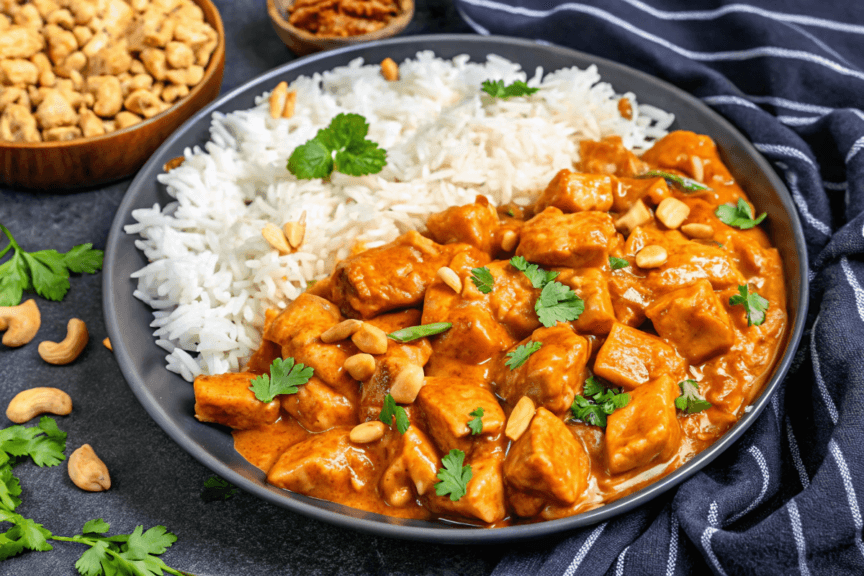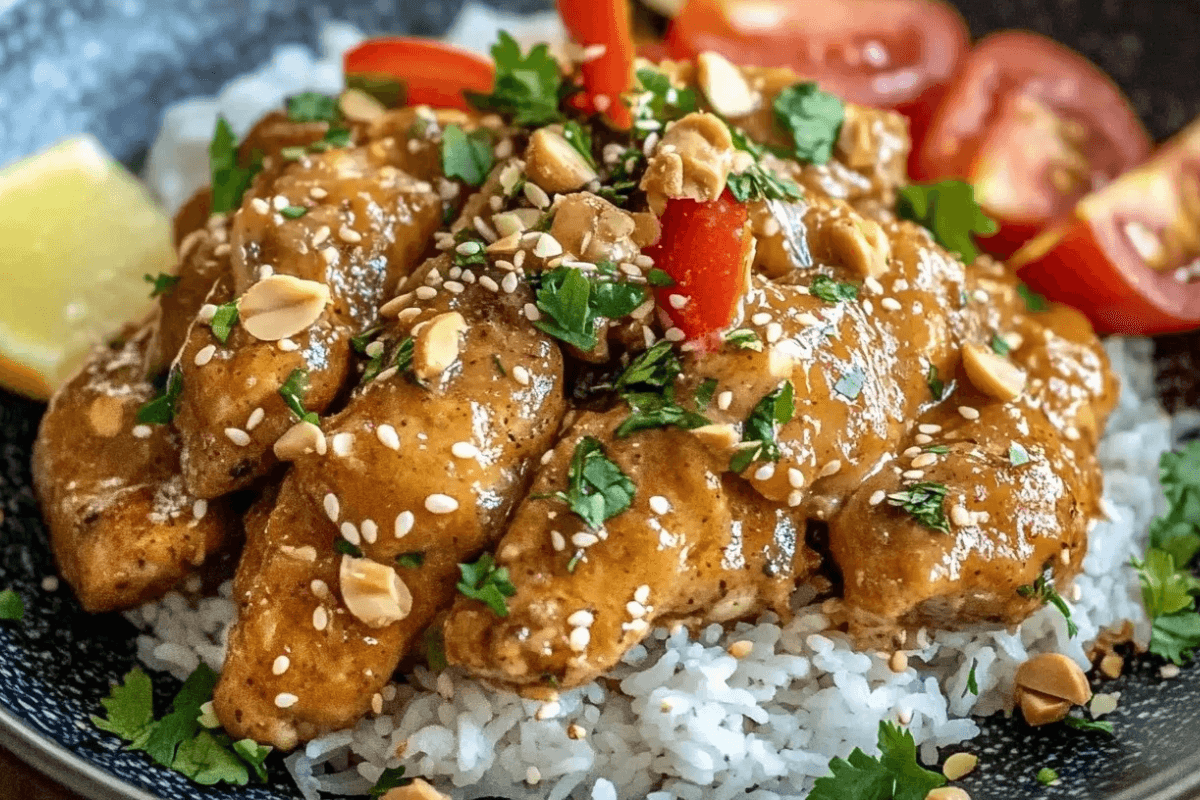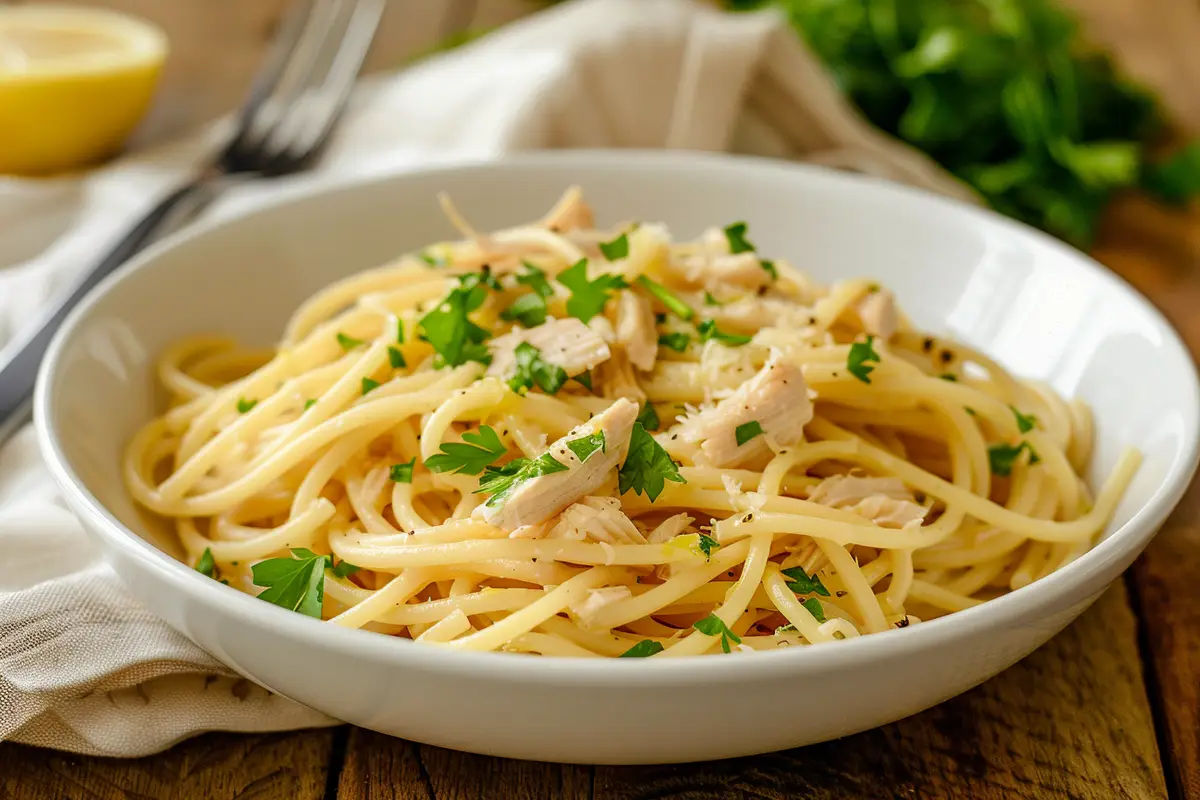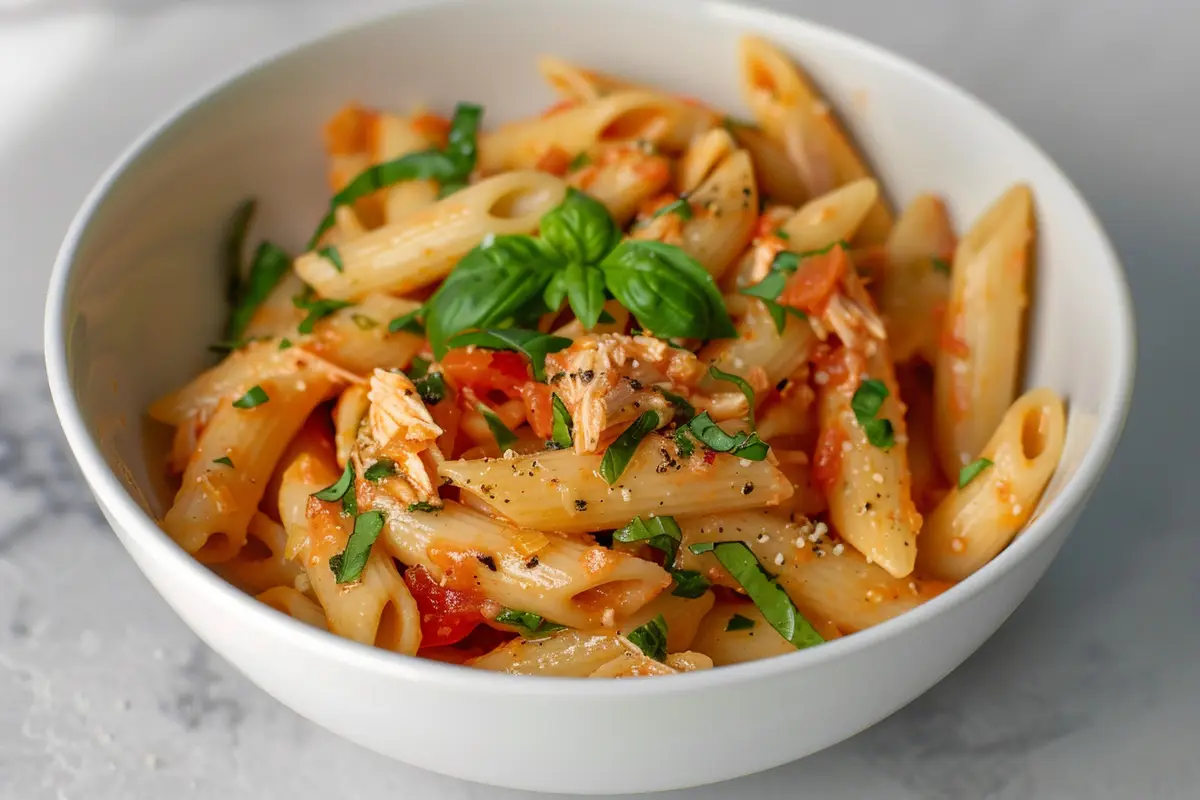Imagine the rich, creamy taste of peanut butter paired with chicken’s savory, tender texture. Sounds like an unexpected delight, right? Peanut butter and chicken recipes are often linked to sandwiches and sweet treats, but they shine in savory dishes too. Their pairing has captured taste buds worldwide. From West African peanut stews to Thai chicken satay, peanut butter and chicken recipes go beyond experimentation. They have become a celebrated culinary tradition.
By the end, you’ll clearly understand how peanut butter and chicken recipes complement each other and how to incorporate them into your cooking. Get ready to discover exciting peanut butter and chicken recipes, practical tips, and all the reasons why this pairing deserves a spot in your kitchen repertoire. Let’s dive in!
Table of Contents
Culinary History of Peanut Butter and Chicken Recipes
This rich history highlights the versatility and timeless appeal of peanut butter and chicken recipes. By exploring their cultural origins, we can appreciate how peanut butter and chicken recipes have evolved and adapted these traditional flavors to suit modern tastes. It’s a pairing that continues to inspire creativity in kitchens around the world.
West African Roots: Groundnut Stews
In West African cuisine, peanuts (commonly referred to as groundnuts) are a staple ingredient, often used in stews and sauces that form the backbone of many traditional meals. Peanut butter and chicken recipes shine in dishes like groundnut stew, also known as maafe or peanut soup. This dish typically features chicken simmered in a rich sauce made from ground peanuts, tomatoes, onions, and aromatic spices such as ginger and garlic. The result is a hearty, comforting meal with layers of flavor—savory, slightly sweet, and nutty.
These stews became popular not just because of their taste but also due to the nutritional value of peanuts added to meals. They provided essential proteins and fats in regions where meat was sometimes scarce, making groundnut stews a practical and flavorful way to stretch ingredients.
Southeast Asia: The Rise of Satay
Halfway across the world in Southeast Asia, peanuts also play a starring role in the beloved dish known as satay. Originating in Indonesia and popularized throughout Thailand, Malaysia, and Singapore, satay features skewered, grilled meats—often chicken—served with a rich, creamy peanut dipping sauce. The sauce combines peanut butter or ground peanuts with coconut milk, tamarind, soy sauce, and spices, creating a flavor profile that’s both sweet and tangy with a hint of heat.
Thai cuisine, in particular, has embraced the peanut-chicken duo in numerous ways. Beyond satay, dishes like Thai peanut curry showcase the versatility of this pairing, blending peanut butter with curry paste, fish sauce, and lime juice for a bold, aromatic experience.
A Global Spread
The pairing of peanut butter and chicken didn’t remain confined to these regions. As trade routes expanded and cultures exchanged ingredients and techniques, the use of peanuts in savory dishes spread globally. For example, Filipino kare-kare is a rich peanut-based stew that sometimes incorporates chicken alongside vegetables and oxtail. In the Americas, where peanuts were introduced during colonial times, peanut butter became a popular ingredient in modern chicken recipes, from casseroles to marinades.
A Modern Twist
Today, peanut butter chicken has found its way into home kitchens and restaurant menus worldwide. It’s celebrated not just for its cultural significance but also for its adaptability. Whether in a spicy African stew, a tangy Thai stir-fry, or a creamy curry, the combination of peanut butter and chicken continues to evolve, delighting food lovers across the globe.
Flavor Profiles and Why They Work Together in Peanut Butter and Chicken Recipes
The combination of peanut butter and chicken might seem unusual at first, but it works remarkably well due to the harmony of their flavor profiles. Each ingredient brings something unique to the table, creating a balance that is both satisfying and versatile. Let’s break down why peanut butter and chicken are such a culinary match made in heaven.
Peanut Butter: Creamy, Nutty, and Rich
Peanut butter is celebrated for its creamy texture and deep, nutty flavor. Its richness brings a luxurious mouthfeel to dishes and acts as a perfect base for sauces, marinades, and curries. Peanut butter also has a subtle sweetness that complements both savory and spicy elements, making it an adaptable ingredient in various cuisines.
- Sweetness and Saltiness: Natural peanut butter has a slight natural sweetness, while processed versions often include added salt. Both profiles enhance the savory elements of chicken, creating a delicious contrast.
- Creaminess: The smooth texture of peanut butter adds a luscious consistency to sauces, making each bite feel indulgent.
Chicken: Versatile and Mildly Savory
Chicken, especially when cooked boneless and skinless, has a mild flavor that readily absorbs marinades and sauces. This makes it a perfect canvas for bold flavors like peanut butter. Whether grilled, baked, or simmered, chicken adapts seamlessly to the creamy and nutty characteristics of peanut-based dishes.
- Neutral Flavor: Chicken’s mildness allows peanut butter to shine without overpowering the dish.
- Texture Contrast: The tenderness of chicken pairs beautifully with the creamy consistency of peanut butter sauces, creating a dynamic eating experience.
A Perfect Base for Layered Flavors
One of the reasons peanut butter and chicken pair so well is their ability to anchor more complex flavors. When combined with ingredients like garlic, ginger, chili, lime juice, or coconut milk, the result is a medley of tastes that hit every part of the palate.
- Sweet and Spicy Fusion: Adding chili or hot sauce to a peanut butter chicken dish creates a spicy kick that balances the nutty sweetness.
- Acidity for Brightness: Ingredients like lime juice, tamarind, or vinegar cut through the richness of peanut butter, providing freshness and balance.
- Aromatic Spices: Spices such as cumin, coriander, or curry powder enhance both peanut butter and chicken, adding depth and warmth.

Global Adaptability
The peanut butter and chicken pairing is not confined to a single style of cooking; its adaptability makes it suitable for a variety of cuisines:
- In African Dishes: The earthy flavors of peanut butter in stews are enhanced with warm spices and hearty vegetables.
- In Asian Cuisine: The combination of peanut butter with soy sauce, sesame oil, and lime juice creates tangy, umami-rich dishes like stir-fries and satays.
- In Fusion Recipes: Peanut butter can be mixed with honey, mustard, or barbecue sauce to create unique marinades for grilled chicken, perfect for Western-style meals.
Texture Enhancements
Beyond flavor, the pairing also provides an interesting textural interplay:
- Smooth peanut butter creates silky sauces that cling beautifully to chicken.
- Crunchy peanut butter adds texture, creating delightful surprises in every bite.
This rich interplay of flavors and textures explains why peanut butter and chicken have stood the test of time in kitchens around the world. Their compatibility serves as a foundation for endless culinary creativity.
Health Benefits of Peanut Butter and Chicken Recipes
Combining peanut butter and chicken isn’t just a culinary delight; it also creates a nutritionally balanced meal packed with protein, healthy fats, vitamins, and minerals. Let’s explore the health benefits each ingredient brings to the table and why this pairing can be a great choice for your diet.
Nutritional Benefits of Peanut Butter
Peanut butter is a powerhouse of nutrients, offering a range of health benefits when consumed in moderation.
- Rich in Protein: Peanut butter contains about 8 grams of protein per 2 tablespoon serving, making it a valuable contributor to muscle building and repair.
- Healthy Fats: It’s loaded with monounsaturated and polyunsaturated fats, which promote heart health by helping to lower bad cholesterol (LDL) levels.
- Vitamins and Minerals: Peanut butter is a good source of essential nutrients like:
- Vitamin E: An antioxidant that protects cells from damage.
- Niacin (Vitamin B3): Supports brain health and energy production.
- Magnesium: Plays a role in bone health, muscle function, and metabolism.
In addition to these benefits, peanut butter’s calorie density provides sustained energy, making it a great ingredient for active individuals or those needing a nutrient-rich boost.
Nutritional Benefits of Chicken
Chicken, particularly lean cuts like breast meat, is a staple in many diets due to its high protein content and low fat.
- High-Quality Protein: Chicken is a complete protein, providing all nine essential amino acids needed for muscle growth and repair.
- Low in Calories and Fat: Skinless chicken breast is especially lean, making it an ideal choice for those watching their calorie intake.
- Packed with Nutrients: Chicken is also rich in:
- Vitamin B6: Supports brain health and aids in red blood cell production.
- Phosphorus: Essential for healthy bones and teeth.
- Selenium: A powerful antioxidant that supports the immune system.
By including chicken in meals, you can enjoy a filling, nutrient-dense protein source that supports a healthy lifestyle.
Why Peanut Butter and Chicken Make a Balanced Meal
When paired together, peanut butter and chicken create a meal that balances macronutrients and provides a host of vitamins and minerals:
- Protein Powerhouse: Both peanut butter and chicken are excellent sources of protein, making this combination ideal for muscle recovery and satiety.
- Healthy Fats and Energy: Peanut butter contributes heart-healthy fats that provide long-lasting energy, while chicken keeps the dish light on saturated fat.
- Vitamins and Minerals: Together, they deliver a range of nutrients that support overall health, from immunity (selenium, vitamin E) to brain function (niacin, vitamin B6).
- Low Glycemic Index: This combination is great for blood sugar control. The fats and protein slow the absorption of carbohydrates, preventing blood sugar spikes.
A Meal for Every Lifestyle
Whether you’re a fitness enthusiast looking to refuel after a workout or simply someone seeking a nutrient-packed dinner, peanut butter chicken is versatile enough to fit various dietary goals:
- Weight Loss: Opt for skinless chicken and natural peanut butter for a lower-calorie, high-protein meal.
- Muscle Building: The protein content supports muscle repair and growth, especially when combined with a side of rice or sweet potatoes for added carbohydrates.
- Heart Health: The monounsaturated fats in peanut butter and the lean protein in chicken contribute to cardiovascular wellness.
Moderation is Key
While peanut butter chicken is packed with nutrients, portion control is important:
- Calorie Awareness: Peanut butter is calorie-dense (about 190 calories per 2 tablespoons), so moderation is essential, especially if you’re watching your calorie intake.
- Sodium Check: Choose natural peanut butter without added sugars or salt to keep the dish healthier.
By combining the rich, nutty flavor of peanut butter with the lean protein of chicken, you can enjoy a dish that not only satisfies your taste buds but also supports a healthy, balanced diet.
Tips for Cooking Perfect Peanut Butter and Chicken Recipes
Creating the perfect peanut butter and chicken recipe requires a balance of flavors, the right cooking techniques, and thoughtful ingredient selection. Whether you’re trying this combination for the first time or perfecting a favorite peanut butter and chicken recipe, these tips will help elevate your cooking experience.
Choose the Right Peanut Butter
The type of peanut butter you use can greatly affect the flavor and texture of your dish.
- Natural Peanut Butter: Opt for natural peanut butter made with minimal ingredients (just peanuts and salt) for the best results. It has a purer flavor and avoids the added sugars and oils found in many commercial brands.
- Crunchy vs. Creamy: Use creamy peanut butter for smooth sauces and stews, while crunchy peanut butter adds texture and interest to certain dishes like wraps or salads.
Balance the Flavors
Peanut butter is rich and slightly sweet, so balancing its intensity with other ingredients is key to a harmonious dish.
- Add Acidity: Ingredients like lime juice, tamarind paste, or vinegar cut through the richness of peanut butter and brighten the overall flavor.
- Incorporate Heat: Chili flakes, sriracha, or fresh chilies add a spicy kick that complements the creamy nuttiness.
- Include Sweetness: A touch of honey, brown sugar, or coconut milk can enhance the natural sweetness of peanut butter and round out the dish.
- Season Generously: Don’t forget salt and spices like garlic, ginger, turmeric, or cumin to create depth and complexity.
Pick the Right Cut of Chicken
The cut of chicken you use depends on the recipe and your preferences:
- Chicken Breasts: Lean and mild, these work well in stir-fries or baked dishes where the peanut sauce provides most of the flavor.
- Chicken Thighs: Juicy and flavorful, thighs are ideal for slow-cooker recipes and stews as they stay tender during long cooking times.
- Bone-In Chicken: Great for grilling or baking, bone-in pieces retain moisture and absorb the flavors of marinades or sauces.
Experiment with Cooking Methods
Different cooking techniques can highlight the versatility of peanut butter chicken.
- Stir-Frying: Ideal for quick meals, stir-frying chicken in a hot pan ensures it stays tender while the sauce clings to each piece.
- Slow Cooking: Perfect for busy days, slow cooking allows the flavors of peanut butter and spices to meld together, creating a rich and tender dish.
- Grilling: For dishes like satay or BBQ chicken, grilling adds a smoky char that contrasts beautifully with the creamy peanut butter sauce.
- Baking: Baking chicken coated in a peanut butter glaze creates a caramelized crust and locks in flavor.
Optimize Texture and Presentation
Thoughtful preparation and presentation can make your dish even more appealing.
- Garnish with Fresh Herbs: Cilantro, parsley, or green onions add a pop of color and a burst of freshness.
- Add Crunch: Top your dish with crushed peanuts, sesame seeds, or crispy shallots for textural contrast.
- Use Vibrant Vegetables: Incorporate colorful veggies like bell peppers, carrots, or broccoli to add visual appeal and nutrition.

Avoid Common Mistakes
Keep these pitfalls in mind to ensure a successful dish:
- Overcooking the Chicken: Chicken can dry out if overcooked, especially lean cuts like breast meat. Monitor cooking times closely.
- Overpowering the Dish: Peanut butter is rich, so avoid using too much. Start with a small amount and adjust to taste.
- Skipping the Sauce Balance: Always taste and adjust the sauce before adding it to the chicken, ensuring the balance of sweetness, acidity, and spice is just right.
Experiment with Substitutes
If you’re looking for a twist on the classic recipe or catering to dietary restrictions:
- Nut-Free Options: Use sunflower seed butter or tahini as a substitute for peanut butter to create allergy-friendly versions of the dish.
- Other Proteins: Try the sauce with tofu, shrimp, or pork for a different take on peanut butter-based meals.
FAQ: Common Questions About Peanut Butter and Chicken Recipes
Here are answers to some frequently asked questions about peanut butter, chicken, and their culinary and nutritional compatibility.
Can chickens eat peanut butter?
Yes, chickens can eat peanut butter, but it should be given in moderation. Peanut butter is calorie-dense and high in fats, which are not harmful to chickens in small amounts but could lead to obesity if overfed. It can be used as a treat or to hide medication for chickens. Make sure to use natural peanut butter without added sugars, salt, or harmful additives like xylitol, which is toxic to animals.
Can we eat chicken and peanut butter together?
Absolutely! Chicken and peanut butter are a delicious and popular combination in many cuisines. From Thai chicken satay with peanut sauce to West African groundnut stew, this pairing creates rich, flavorful dishes. Peanut butter adds creaminess and nuttiness to chicken, which serves as a versatile and protein-rich base. The combination is tasty and nutritious when balanced with other ingredients like vegetables and grains.
What does peanut butter taste good on?
Peanut butter pairs well with both sweet and savory foods. Some popular pairings include:
Sweet Pairings: Bread, bananas, apples, chocolate, and honey.
Savory Pairings: Chicken, beef, tofu, vegetables like carrots and celery, and in sauces for noodles or rice.
Peanut butter’s versatility makes it a staple in many recipes, from desserts to hearty main dishes.
Is a peanut meal good for chickens?
Yes, peanut meal can be good for chickens when used as part of a balanced feed. Peanut meal, the byproduct of peanut oil extraction, is high in protein and energy, making it a beneficial supplement for poultry feed. However, it should be properly processed to remove aflatoxins, which can naturally occur in peanuts and are harmful to chickens. Always consult a veterinarian or poultry nutritionist before introducing new feeds to ensure the diet is safe and appropriate.
Conclusion: Why You Should Try Peanut Butter and Chicken Recipes
Peanut butter and chicken might seem like an unconventional duo at first glance, but their compatibility in taste, texture, and nutritional value has made them a beloved combination across cuisines worldwide.
From West African groundnut stews to Thai chicken satay, this pairing transcends cultural boundaries, offering rich, flavorful dishes that are both satisfying and nutritious.
The creamy, nutty flavor of peanut butter complements chicken’s mild, tender profile, creating a versatile foundation for a variety of dishes.
Whether you’re simmering a hearty curry, grilling skewers for a barbecue, or tossing a quick stir-fry, this pairing adapts beautifully to your cooking style and taste preferences.
Nutritionally, peanut butter provides healthy fats, protein, and essential nutrients, while chicken offers lean protein and a range of vitamins and minerals. Together, they form a balanced meal that supports muscle growth, sustained energy, and overall well-being. However, as with any dish, moderation and thoughtful ingredient choices are key. Opt for natural peanut butter, balance flavors with acidity and spice, and consider dietary needs such as allergies or calorie content.
Incorporating peanut butter and chicken into your meals isn’t just about the taste—it’s about exploring a fusion of flavors and experimenting with ingredients to create something truly special. Whether you’re a seasoned chef or a home cook looking for new inspiration, this combination is a delightful way to expand your culinary horizons.
So, the next time you’re planning your menu, don’t hesitate to try peanut butter chicken. You’ll not only enjoy a delicious meal but also pay homage to a pairing celebrated in kitchens around the globe. Happy cooking!







